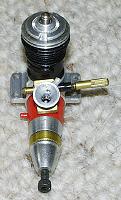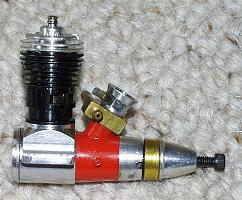


The Cox TeeDee 051. This example has been fitted with KustomKraftsmanship Allen Key prop screw, 128 tpi needle valve assembly and a pressure tapped backplate. I epoxied a flood-off inlet into the venturi.
   |
|
The Cox TeeDee 051. This example has been fitted with KustomKraftsmanship Allen Key prop screw, 128 tpi needle valve assembly and a pressure tapped backplate. I epoxied a flood-off inlet into the venturi. |
Leroy Cox's little gem was head and shoulders above the competition when it appeared, with a maximum output or 0.125 bhp at 21,500 rpm. The example shown above weighs 46.4g, so it is amongst the lightest engines of its capacity. In addition, individual engines were amazingly consistent as the result of having fits so good that all parts were interchangeable. It was the first production engine to have all its metal parts machined from bar stock. It was the standard to beat for power from the start of production in 1960 until the Shuriken appeared around 1990. Production standards and fits were impeccable until Leroy got burnt by the end of the slot car craze and sold out to K&B. After that the business went through several hands before ending up with Estes Industries, who stopped production of the TeeDee range. After Leroy sold out subsequent owners let the factory equipment deteriorate and production quality suffered, opening the door to a variety of specialists who supplied better accessories and tuning services. One of these was Joe Krause who traded as KustomKraftsmanship and modified the engines as follows:
The modified engine was good for around 20500 on a Lars G Olofsson's glass 5.75 x 3 (a clipped version of the Cox black plastic 6 x 3 with thinned and narrowed blades). Good thrust was also generated using an APC 5.7 x 3, which was designed for the TeeDee 049 and 051. None of the more modern glow plug engines develop enough torque to suit this propeller. I always propped my TeeDees to run at around 21,500 rpm in the air, figuring that maximum thrust would be developed at the same rpm as maximum power and that higher rpm meant using smaller props with a consequent drop in static thrust and acceleration. However, many other fliers preferred to use relatively small props and run the engines at anything up to 25,000 rpm. At these speeds life could be reduced and there was a tendency for the crank pin to break off the crankshaft. This could be prevented by heat treating the crankshaft before running the engine. The kitchen oven was set to its maximum temperature and the crankshaft put in it. The oven was held at its maximum temperature for an hour and then turned right down and allowed to cool slowly.
Cox TeeDee 049 and 051 engines were visually identical from the outside, so the plastic carburetter mounts were colour coded to indicate which was which. 049s had a black mount and the 051s a red mount. Both had a pressure feed nipple on the right side of this housing. I never used it because: